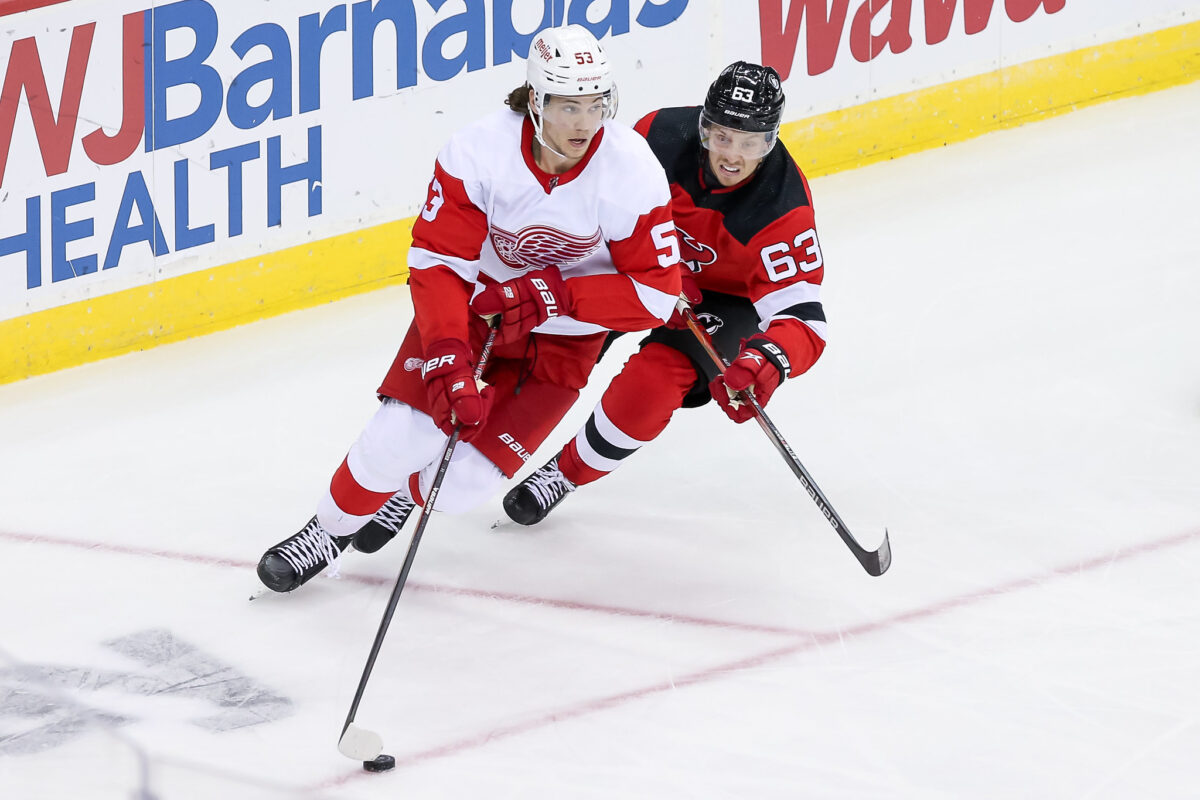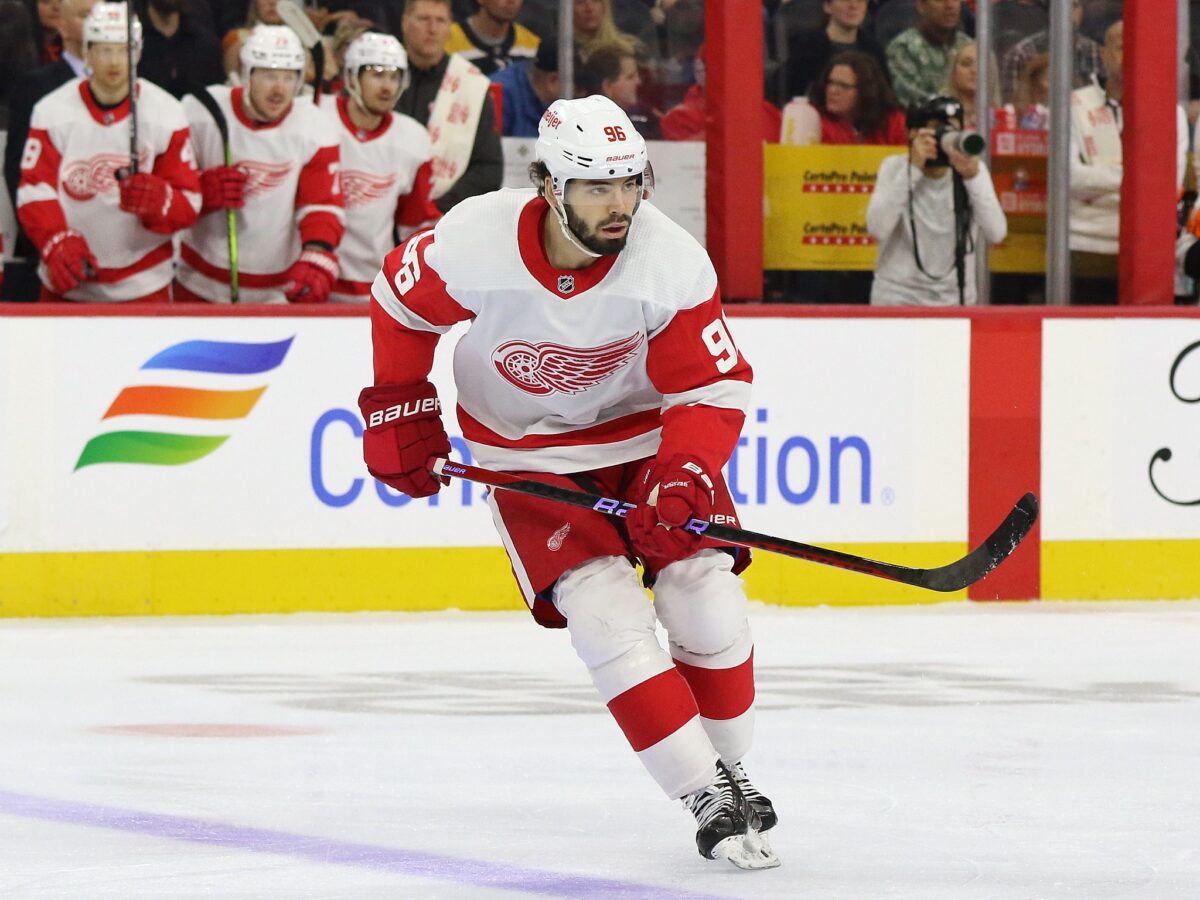That was a rough month of December for the Detroit Red Wings. After a strong start to the season, the Red Wings closed out the calendar year with 10 losses in 15 games – not ideal for a playoff push.
They’ve also given up a lot of goals as of late – 4.27 per game in December, to be exact. That’s the most in the NHL during that span. The most. More than the bottom-feeding San Jose Sharks, Chicago Blackhawks, and Columbus Blue Jackets.
What’s going on with the Red Wings? Why are they giving up so many goals? I dove into the numbers and analyzed their recent play to find out.
Seider & Walman Having Tough Year
When your top pair isn’t performing like a top pair, that’s an issue. That said, Detroit’s coaching staff isn’t making it easy on them.
So far this season, Moritz Seider and Jake Walman have had the toughest deployment of any defense pairing in the league. As a result, they have the eighth-worst expected goals-against per 60 (xGA/60) stat line (2.94) among defense pairs that have been together for at least 200 minutes of five-on-five hockey.

In addition, Seider and Walman have seen their five-on-five scoring chances-against (SCA/60) and high-danger chances-against (HDCA/60) numbers plummet. Their penalty kill metrics have been rough, too. Seider and Walman own the fifth-worst xGA/60 (12.00) while shorthanded and fourth-worst HDCA/60 (40.75) among pairs playing 20-plus penalty kill minutes together.
Two things can be true here: 1) Seider and Walman have not performed like a top pair, and 2) they are still learning how to be a top pair. Sure, effort and execution could be better, but it’s reasonable to chalk this trend up to growing pains.
Red Wings’ Defensive Zone Coverage
Seider and Walman aren’t the only Red Wings struggling in their own zone. The constantly changing lineup has prevented forward lines and defense pairs from developing meaningful chemistry. And because of this, defensive zone coverage can quickly descend into chaos.

All it takes is one – one missed assignment, one bad pinch, one poor decision. Then, things start spiraling. After a wide-open opponent gets the puck, players overcompensate, leave their coverage zone, and rush to fill in a gap. That leaves other opponents open in high-danger areas.
This series of events happens quite frequently – so much so that the Red Wings have the highest high-danger goals-against per 60 (HDGA/60) at five on five in December (2.19).
Apart from Walman and Seider, Dylan Larkin, David Perron, and Joe Veleno have the worst HDGA/60 rating on an individual level. I can’t say this is surprising – Perron and Larkin missed a significant amount of time and had to adapt to new linemates upon their return. Veleno hasn’t had consistent linemates—or a consistent position—either.
Related: Optimizing the Red Wings’ Lineup & Power Play
Unless the team shores up its defensive zone coverage, goals are going to keep going in regardless of who is in net. Speaking of which…
Red Wings Need More From Their Goalies
This season, Detroit’s goalies have been fine. But fine isn’t good enough with the team that’s in front of them.
When you play fine, you get stat lines like these:
Few timely saves. Few stolen games. Just not enough to bail the team out.
To put this into perspective, just take a look at the amount of quality starts generated by Ville Husso and James Reimer – Detroit’s top two goalies entering the season. Six of Husso’s 17 starts were of the quality variety. Reimer has three quality starts in 10 tries.
Related: 3 Ways to Fix the Red Wings’ Goaltending Situation
For those counting at home, that’s a quality start in only a third of the games started by the top two goalies. That’s just not good enough. It’s not all on the goalies. They need to contribute more, though.
Next Steps For the Red Wings
All of the issues mentioned above can be fixed. Some will take more time than others, but it’s still possible to right the ship and re-enter the playoff race.
Here are a few solutions to address these problem areas:
- Lineup consistency – Find effective lines/pairings and stick with them to build chemistry.
- Defensive zone scrutiny – Increase the focus on defensive zone coverage and, if necessary, adopt a more conservative game strategy.
- Blue line deployments – Lean more on Chiarot/Petry pairing to give the top pair a break and build their confidence with more offensive zone starts.
- Goalie strategy – Play only Husso or Lyon moving forward; explore the goalie market if neither seize the opportunity.
It’s a vicious circle. Risky plays beget goals against, and being down a goal (or two) brings about more risky decisions and more goals against. Now it’s up to the Red Wings to break free of these tendencies.
Data courtesy of NHL.com, MoneyPuck, Natural Stat Trick, Hockey Reference, and Puck IQ.
